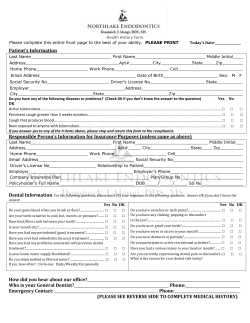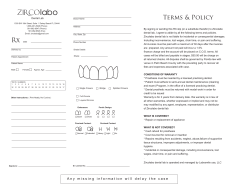
PDF Fulltext
Krishna et al: Dental root resorption Review Article An orderly review of dental root resorption Krishna R1, Ali SN2, Pannu D3, Peacock ME4, Bercowski DL5 ABSTRACT 1 Dr Ranjitha Krishna DMD, MPH, MSD, Assistant Professor, Department of Periodontics, Rkrishna@gru.edu This article explores the multifactorial etiology of root resorption, broad classification, pathogenesis, radiographic interpretation, and 2 Dr Shafee Naaz Ali BDS, Sri Sai College of Dental Surgery, Vikarabad, Andhra Pradesh, India, shafinaaz234@gmail.com 3 Dr Darshanjit Pannu DDS, FACP, Assistant Professor Department of Oral Rehabilitation dpannu@gru.edu 4 Dr Mark E Peacock DMD, MS, Associate Professor, Department of Periodontics Mpeacock@gru.edu 5 Daniel Levy-Bercowski, DDS Associate Professor, Department of Orthodontics Dbercowski@gru.edu 1,3,4,5 Georgia Regents University Augusta, Received: 20-09-2014 Revised: 02-10-2014 Accepted: 21-11-2014 treatment challenges. Root resorption related to orthodontic treatment is discussed with case example. Key Words: Root, resorption, orthodontic, radiographic, treatment Correspondence to: Dr Ranjitha Krishna 706-721-2442 Rkrishna@gru.edu Introduction Root resorption is a physiologic or pathologic phenomenon where the dentin, cementum, or bone is being resorbed irreversibly leading to mobility of the tooth. Diagnosis and treatment of teeth with root resorption is clinically challenging and therefore, clinical practitioner needs to have a proper understanding of its etiology and pathogenesis to provide the desired outcome. Physiologic resorption is a natural process caused by the pressure of the underlying permanent tooth, leading to exfoliation of the deciduous tooth. IJMDS ● www.ijmds.org ● January 2015; 4(1) Pathologic resorption on the other hand, is multifactorial, which when left untreated leads to premature loss of the tooth. A review of multifactorial etiology of root resorption is presented in table 1. [1-10] Based on the location in regards to the tooth structure, root resorption is broadly classified into internal resorption and external resorption. Internal resorption are seldom seen, are often asymptomatic, and usually detected on routine radiographic examination. External resorption is further classified into external surface resorption, external inflammatory 669 Krishna et al: Dental root resorption resorption, external replacement resorption, external cervical resorption, and transient apical breakdown. [11,12] TABLE 1 Etiology of Root Resorption: The following factors are highly susceptible to root resorption Biological Factors Genetics Autosomal dominant, autosomal recessive, or hereditary determinant by a few genes Systemic Factors Allergic patients Nutrition Lack of calcium and vitamin D Chronological age Age affects the vascularity of Periodontal membrane, and the density of bone increases Bruxism, tongue thrust coupled with open bite, and elevated tongue pressure Habits Anomalies of position and number of Impacted third molars usually cause root teeth resorption of second molars. Impacted maxillary canines resorbs roots of premolars and incisors Dental trauma Concussion, luxation, replantation, transplantation Endodontically treated teeth Filling root canals short of its apex leads to resorption Specific tooth vulnerability Maxillary teeth more vulnerable to resorption than mandibular teeth; anterior teeth more vulnerable than posterior teeth Mechanical Factors Orthodontic Treatment fracture, Fixed appliances, use of aesthetic brackets, use of elastics, using force greater than 20-26g/cm2 show greater susceptibility to root resorption Pathogenesis The mechanism of root resorption has not been fully understood. However, the major IJMDS ● www.ijmds.org ● January 2015; 4(1) grounds of resorption are conducted by the multinucleated giant cells. These cells arrive at resorption site via blood stream and are 670 Krishna et al: Dental root resorption differentiated to odontoclasts and osteoclasts. The differentiation is highly dependent on factors produced by bone marrow stromal cells and includes: RANK (receptor activator of nuclear factor kappa B) ligand (RANKL) and osteoprotegerin (OPG). [13] The differentiated odontoclasts and osteoclasts degrade the inorganic mineral structure followed by disintegration on the organic matrix. When the stimulating factor is mechanical, for example, orthodontic treatment, removal of the pressure will reverse the process. Diminutive dented areas are repaired by cementum-like tissue, whereas, bone cells get attached to the outsized areas resulting in ankyloses. [14] Radiographic Interpretations The root canal walls along with the continuity of the lesion are decisive in determining the resorption to be Internal or External. Internal resorptions are usually symmetrical disrupting the continuity of the radiolucent pulp chamber is lost. External resorptions on the contrary are asymmetrical. Furthermore, buccal-object rule assists in distinguishing root defect to be buccal or lingual-palatal.[15] Since the periapical film is two-dimensional, buccal object rule determines the buccolingual direction of the defect. Two different angled radiographs are made of an object; the defect moves mesial when the tubehead is moved mesially, explains that the defect is located lingually. If the defect moves distal when the object moves mesially, explain that’s the defect is located buccally. Case example Below is an example of external root resorption associated observed after orthodontic treatment in a 13 year old IJMDS ● www.ijmds.org ● January 2015; 4(1) female who presented to the GRU orthodontic clinic. (Fig. 1) She was medically healthy and not on any medications. Upon clinical examination, (Fig. 2) she was diagnosed with skeletal class II malocclusion and a decrease in vertical pattern, Dental Class II Div 2 mal-occlusion. She was also missing upper right lateral incisor and had a peg shaped upper left lateral incisor. Treatment consisted of upper and lower full bonding with a device exerting forces to correct the class II malocclusion and create the space for restorative treatment on the left lateral incisor and implant on the right lateral incisor space. (Fig. 3) The total treatment time was 40 months in treatment. Final radiograph shows root resorption of upper anterior teeth due to orthodontic forces applied during the treatment. (Fig. 4) Fig. 1 Initial intraoral photograph of the patient Fig. 2 Initial radiograph of the 13 year old female patient 671 Krishna et al: Dental root resorption elucidation of favorable and unfavorable state of root resorption with its prognosis and treatment consideration. TABLE 3 External Resorption Fig. 3 Final radiograph after 40 months of treatment Fig. 4 Root resorption seen on the upper anterior teeth Treatment Challenges Rendering effective treatment for root resorption is highly dependent on identification of type of resorption and its stimulating factor. The prognosis is good unless the lesions are perforating, which may need extraction due to poor prognosis. Table 2 and Table 3 present a brief TABLE 2 Internal Resorption Favorable Small to medium size defect, no perforations observed Treatment Consider Root Canal treatment Prognosis Good Prognosis Unfavorable Large defect perforating the external root surface Consider Extraction Poor Prognosis IJMDS ● www.ijmds.org ● January 2015; 4(1) Favorable When the Root Resorption is due to mechanical pressure, removal of the pressure usually ceases the resorption. Unfavorable When there is excessive loss of structural integrity of the tooth associated with mobility, consider extraction. Conclusion Identification of root resorption in clinical practice requires detailed past medical history, germane information of tooth involved, for example, traumatic incidents such as concussion and subluxation, any sport if practiced, previous endodontic treatment, and associated diseases. Early diagnosis is the key to a better prognosis. Considering time to be a crucial factor, this paper helps clinician with diagnosing and treatment planning of pathological root resorption. References 1. Lopatiene K, Dumbravaite A. Risk factors of root resorption after orthodontic treatment. Stomatologija / issued by public institution "Odontologijos studija" [et al] 2008;10(3):89-95. 2. Brezniak N, Wasserstein A. Orthodontically induced inflammatory root resorption. Part II: The clinical aspects. The Angle orthodontist 2002;72(2):180-4. 3. Brezniak N, Wasserstein A. Root resorption after orthodontic treatment: Part 2. Literature review. American journal of 672 Krishna et al: Dental root resorption 4. 5. 6. 7. 8. 9. orthodontics and dentofacial orthopedics: official publication of the American Association of Orthodontists, its constituent societies, and the American Board of Orthodontics 1993;103(2):138-46. Hartsfield JK, Jr., Everett ET, Al-Qawasmi RA. Genetic Factors in External Apical Root Resorption and Orthodontic Treatment. Critical reviews in oral biology and medicine : an official publication of the American Association of Oral Biologists 2004;15(2):115-22. Tabiat-Pour S, Newlyn A. Root resorption of a maxillary permanent first molar by an impacted second premolar. British dental journal 2007;202(5):261-2. Savage RR, Kokich VG, Sr. Restoration and retention of maxillary anteriors with severe root resorption. Journal of the American Dental Association 2002;133(1):67-71. Nigul K, Jagomagi T. Factors related to apical root resorption of maxillary incisors in orthodontic patients. Stomatologija / issued by public institution "Odontologijos studija" [et al] 2006;8(3):76-9. Travess H, Roberts-Harry D, Sandy J. Orthodontics. Part 6: Risks in orthodontic treatment. British dental journal 2004;196(2):71-7. Sameshima GT, Sinclair PM. Predicting and preventing root resorption: Part I. Diagnostic factors. American journal of orthodontics and dentofacial orthopedics: official publication of the American Association of Orthodontists, its constituent societies, and the American Board of Orthodontics 2001;119(5):505-10. IJMDS ● www.ijmds.org ● January 2015; 4(1) 10. Jiang RP, Zhang D, Fu MK. [A factors study of root resorption after orthodontic treatment]. Zhonghua kou qiang yi xue za zhi = Zhonghua kouqiang yixue zazhi = Chinese journal of stomatology 2003;38(6):455-7. 11. Patel S, Kanagasingam S, Pitt Ford T. External cervical resorption: a review. Journal of endodontics 2009;35(5):616-25. 12. Ne RF, Witherspoon DE, Gutmann JL. Tooth resorption. Quintessence international 1999;30(1):9-25. 13. Fernandes M, de Ataide I, Wagle R. Tooth resorption part I - pathogenesis and case series of internal resorption. Journal of conservative dentistry: JCD 2013;16(1):4-8. 14. Fuss Z, Tsesis I, Lin S. Root resorption-diagnosis, classification and treatment choices based on stimulation factors. Dental traumatology : official publication of International Association for Dental Traumatology 2003;19(4):175-82. 15. Trope M. Root Resorption due to Dental Trauma. Endodontic Topics 2002;1(1):79100. Cite this article as: Krishna R, Ali SN, Pannu D, Peacock ME, Bercowski DL. An orderly review of dental root esorption. Int J Med and Dent Sci 2015; 4(1):669-673. Source of Support: Nil Conflict of Interest: No 673
© Copyright 2025










